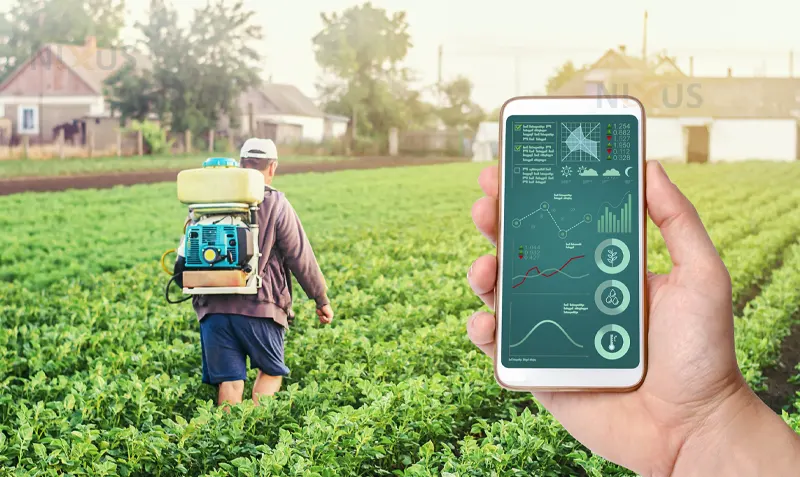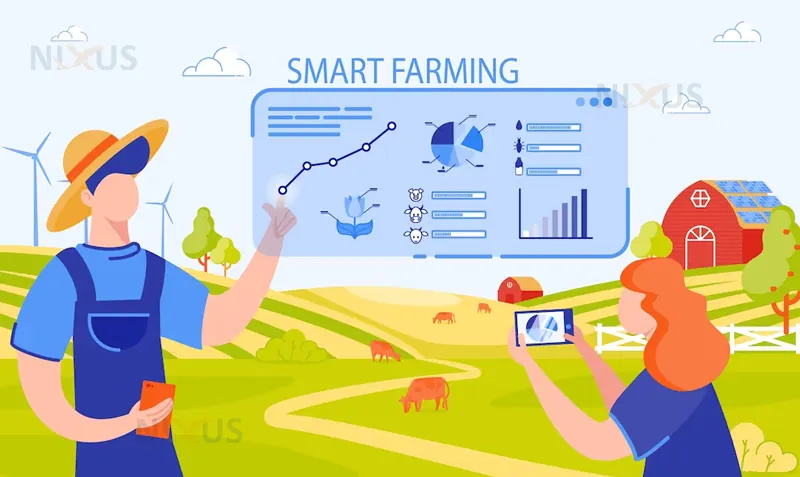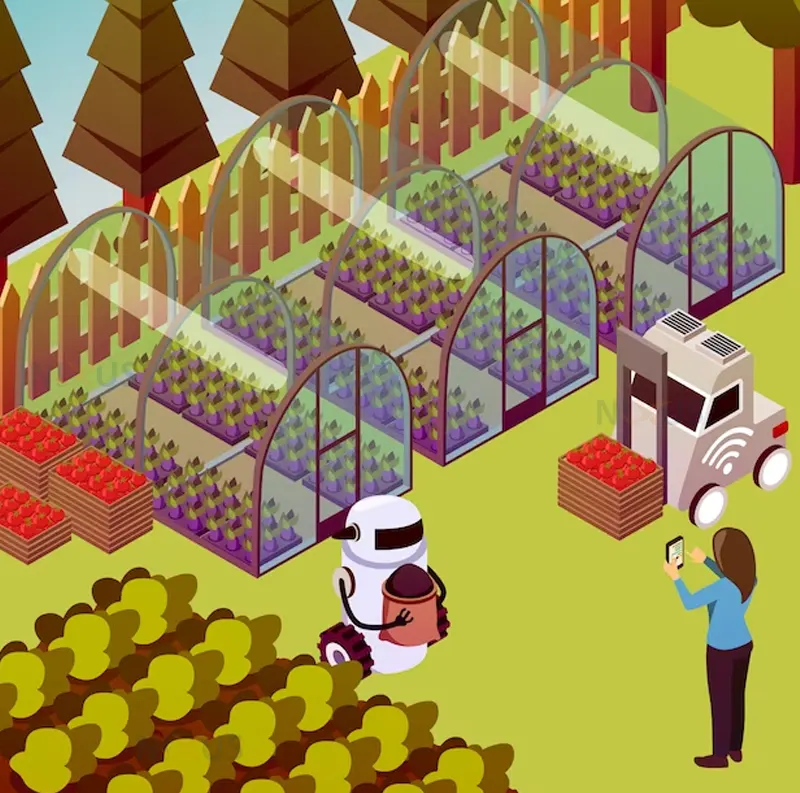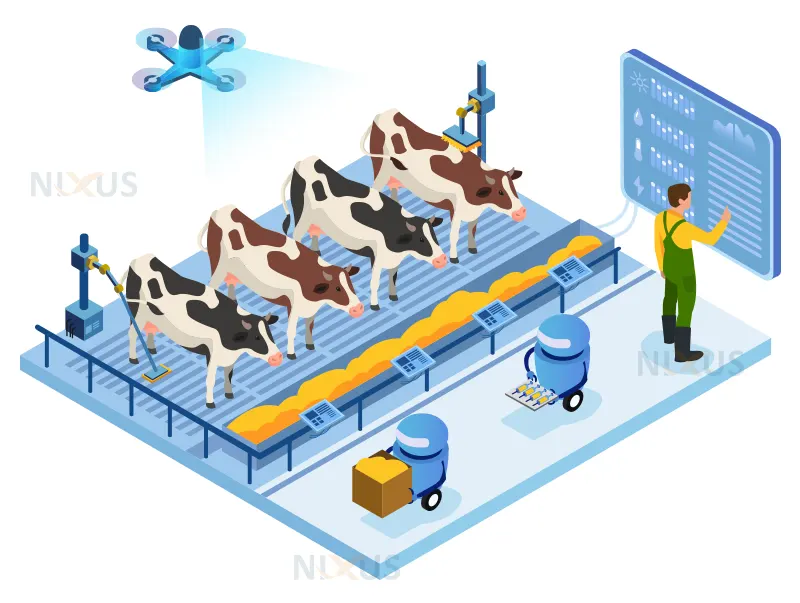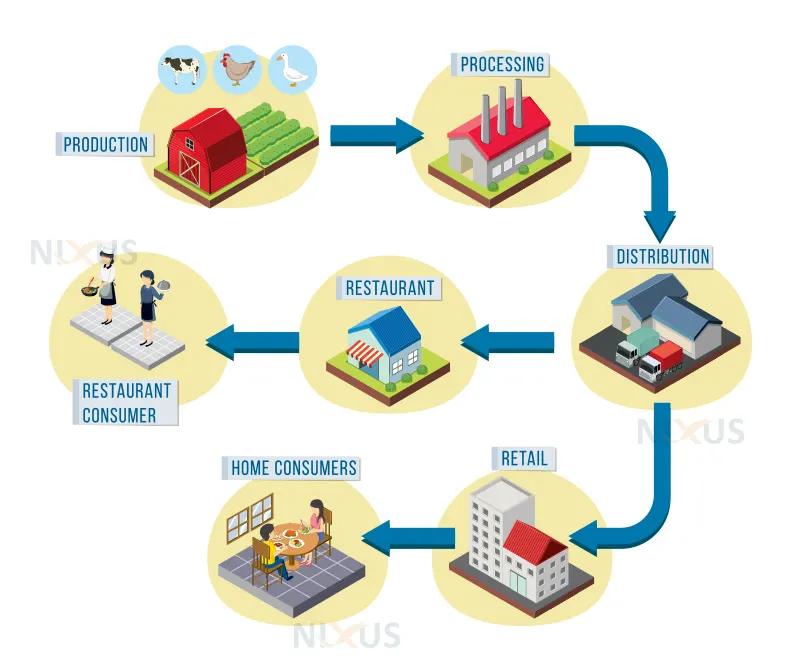AI in Agriculture
Artificial intelligence (AI) is rapidly being utilized in farming to boost productivity, reducing waste, and raise crop production. AI technologies, such as precision farming and crop monitoring and prediction, can help farmers make more informed decisions and optimise their operations.
AI has the ability to significantly assist the farming business in areas other than economy and production. For example, AI can be used to optimise supply chains, improve livestock management, and enhance food safety and quality.
However, the use of AI in agriculture also raises a number of challenges and limitations, including the need for accurate data, ethical and privacy concerns, and limited adoption and infrastructure. Ensuring that AI is developed and deployed in a responsible and ethical manner will be crucial to the success and acceptance of these technologies in the agriculture industry.
The potential benefits of AI in agriculture
Machine learning (AI) has the ability to significantly assist farming, such as:
1. Improved efficiency and productivity: AI technologies, such as precision farming and crop monitoring and prediction, can help farmers make more informed decisions and optimise their operations. This can lead to increased efficiency, reduced waste, and higher crop yields.
2. Supply chain optimization: AI may be utilised to improve agricultural production networks, increasing effectiveness and lowering prices.
3. Livestock management: AI can be used to improve livestock management, including monitoring and predicting animal health, optimising feeding and watering schedules, and enhancing food safety and quality.
4. Crop monitoring and prediction: AI may be utilised to observe plants and anticipate prospective crop production, allowing producers to take better educated cultivation and harvesting selections.
5. Food safety and quality: AI can be used to enhance food safety and quality, including detecting contaminants in food and predicting foodborne illness outbreaks.
Applications of AI in agriculture
Precision farming
Precision farming is a kind of agriculture in which sophisticated technology such as artificial intelligence (AI) are used to enhance agricultural techniques and increase effectiveness and output.
In precision farming, AI technologies are used to monitor and analyse data from a variety of sources, including sensors, drones, and satellite imagery. This data can be used to optimise planting and fertilisation schedules, predict future crop yields, and detect and address pests and diseases.
The utilisation of drones to gather data on agricultural technology and soil quality is one instance of precision farming using AI. This data can be used to identify areas of the field that are in need of more water or nutrients, and to optimise irrigation and fertilisation schedules.
One instance is the utilisation of satellite images and algorithmic machine learning to forecast agricultural yields in the past. This can assist farmers take more educated cultivation and harvesting choices, as well as lessen the danger of over- or under-planting.
Crop monitoring and prediction
Artificial intelligence (AI) can be used to monitor crops and predict future crop yields, enabling farmers to make more informed decisions about planting and harvesting. AI may be utilised for crop forecasting and surveillance in a variety of methods, such as:
- Satellite imagery: AI can be used to analyse satellite imagery to monitor crops and predict future crop yields.
- Sensors: Sensors can be placed in fields to collect data on factors such as temperature, humidity, and soil moisture. AI can be used to analyse this data to monitor crops and predict future crop yields.
- Machine learning systems may be taught on information from past agricultural seasons to forecast crop output in the future.
By using AI for crop monitoring and prediction, farmers can make more informed decisions about planting and harvesting, optimising their operations and increasing efficiency. This can result in increased agricultural yields and increased revenue for farmers.
Robotics
Robots and AI are being used in agriculture to help with tasks such as planting, harvesting, and monitoring crops.
For example, autonomous tractors can be used for planting and harvesting, drones can be used for crop spraying and monitoring, and machine learning algorithms can be used for precision agriculture, such as identifying and addressing issues with specific plants.
Additionally, AI and Robotics can be used for monitoring animal behaviour, milking and feeding tasks, and even for sorting and grading produce at packing facilities.
Livestock management
Artificial intelligence (AI) has the capability to greatly enhance agricultural management of supply chains.
- Monitoring and predicting animal health: AI can be used to monitor the health of livestock and predict potential health issues. This can help farmers prevent illness and improve animal welfare.
- Optimising feeding and watering schedules: AI can be used to optimise feeding and watering schedules for livestock, improving efficiency and reducing waste.
- Enhancing food safety and quality: AI can be used to detect contaminants in food and predict foodborne illness outbreaks, improving food safety and quality.
- Predictive breeding: AI can be used to predict the genetic potential of animals, enabling farmers to make more informed breeding decisions.
By using AI to optimise feeding and watering schedules, enhance food safety and quality, and predict animal health issues, farmers can improve efficiency, reduce waste, and improve animal welfare.
Supply chain optimization
Artificial intelligence (AI) has the capability to greatly enhance agricultural management of supply chains. AI technologies, such as machine learning and predictive analytics, can be used to optimise supply chains in a number of ways, including:
- Demand forecasting: AI can be used to predict future demand for agricultural products, enabling farmers and suppliers to optimise production and inventory management.
- Optimising logistics: AI can be used to optimise logistics in the agriculture industry, including routing and scheduling transportation, predicting delivery times, and minimising transportation costs.
- Quality control: AI can be used to monitor and optimise the quality of agricultural products throughout the supply chain, ensuring that products meet quality standards and minimising waste.
- Fraud prevention: Artificial intelligence (AI) may be used to identify fraudulent actions in the agriculture business, such as manufacturing and brand fabrication.
Overall, artificial intelligence has the ability to greatly enhance agricultural supply chain management, offering major advantages to producers, providers, and customers.
By using AI to optimise production and inventory management, optimize logistics, monitor product quality, and detect fraudulent activities, the agriculture industry can improve efficiency, reduce costs, and enhance customer satisfaction.
Challenges and limitations of AI in agriculture
The need for accurate data
Accurate data is crucial for the success of artificial intelligence (AI) and machine learning, as it is used to build and train models and make predictions and decisions. Without accurate data, AI systems can make incorrect or biassed decisions, leading to poor results and potentially harmful consequences.
In the agriculture industry, accurate data is particularly important for applications such as precision farming, crop monitoring and prediction, and livestock management. These applications rely on accurate data about factors such as weather, soil conditions, crop yields, and animal health. Without accurate data, these AI systems can make incorrect predictions and decisions, leading to poor results and potentially harmful consequences.
Ensuring the accuracy of data in the agriculture industry is a complex task, as it requires the collection of high-quality data from a variety of sources, including sensors, drones, and manual data entry. It also requires the use of reliable data storage and management systems to ensure that data is stored and managed securely and accurately.
The need for accurate data is crucial for the success of AI in the agriculture industry, and it is important for developers and policymakers to prioritise the collection and management of high-quality data in order to ensure the success and reliability of these technologies.
Ethical and privacy concerns
The application of artificial intelligence (AI) in agriculture involves several ethical and privacy problems, including:
Data privacy: The collection and use of data in the agriculture industry can raise concerns about data privacy, as it may include sensitive personal and financial information. It is important for developers and policymakers to ensure that data is collected and used in a responsible and ethical manner, and that appropriate measures are in place to protect data privacy.
Bias: AI systems can be biassed if they are trained on biassed data. This can result in unjust or biassed findings, thus programmers and legislators must guarantee that AI systems are educated on varied and representative data to reduce prejudice.
Transparency: AI systems can be difficult to understand and explain, making it difficult for users to understand how they make decisions and predictions. This absence of transparency can raise issues about transparency and confidence, thus programmers and governments must work together to guarantee that AI systems are visible and comprehensible.
Ethical use: The application of AI in agriculture can generate ethical problems, such as the influence on livelihood and the possibility of AI being used maliciously. It is important for developers and policymakers to ensure that AI is used ethically and for the benefit of society.
Limited adoption and infrastructure
One of the challenges and limitations of artificial intelligence (AI) in the agriculture industry is limited adoption and infrastructure. Many farmers and agricultural businesses may be hesitant to adopt new technologies, and may not have the necessary infrastructure in place to support these technologies.
In order for AI to be successfully adopted and deployed in the agriculture industry, it is important for developers and policymakers to address these challenges and limitations. This may involve providing education and training to farmers and agricultural businesses about the benefits and uses of AI, as well as providing support and resources to help them implement these technologies.
It is also important for the agriculture industry to have the necessary infrastructure in place to support AI technologies, including reliable internet and power, as well as the necessary hardware and software. Developing and maintaining this infrastructure can be a challenge, and it is important for developers and policymakers to ensure that it is in place to support the adoption and deployment of AI technologies.
Conclusion
In conclusion, artificial intelligence (AI) has the potential to revolutionise the agriculture industry and bring significant benefits to farmers and consumers. AI technologies, such as precision farming and crop monitoring and prediction, can improve efficiency, reduce waste, and increase crop yields.
However, it is important for developers and policymakers to carefully consider the ethical and privacy implications of AI in agriculture. Ensuring that AI is developed and deployed in a responsible and ethical manner will be crucial to the success and acceptance of these technologies in the agriculture industry.
Overall, the potential for AI to revolutionise agriculture is significant, and it has the potential to bring significant benefits to farmers, consumers, and the industry as a whole.
By carefully considering the ethical and privacy implications of AI and developing these technologies in a responsible and ethical manner, we can ensure that AI has a positive impact on the agriculture industry.
